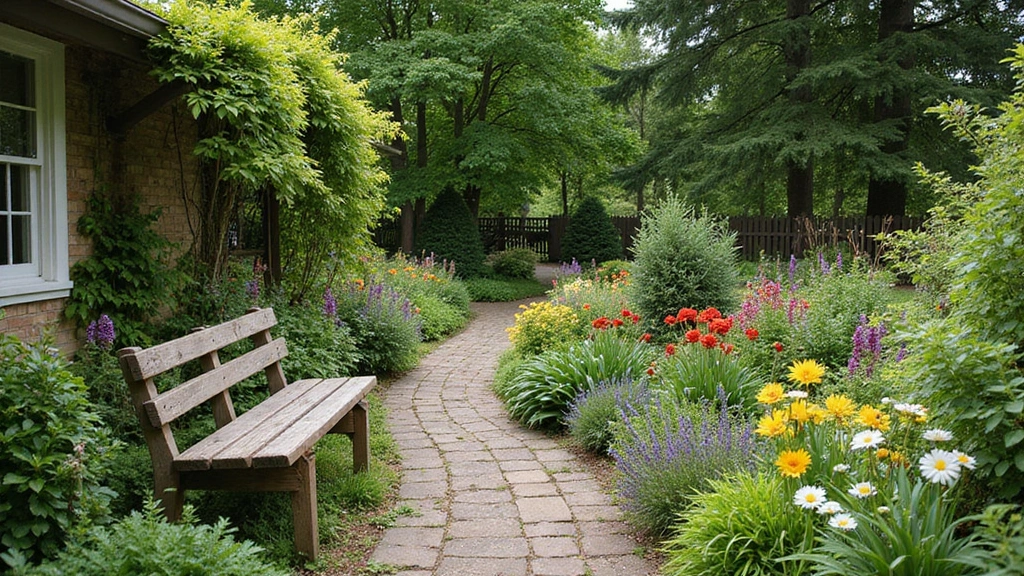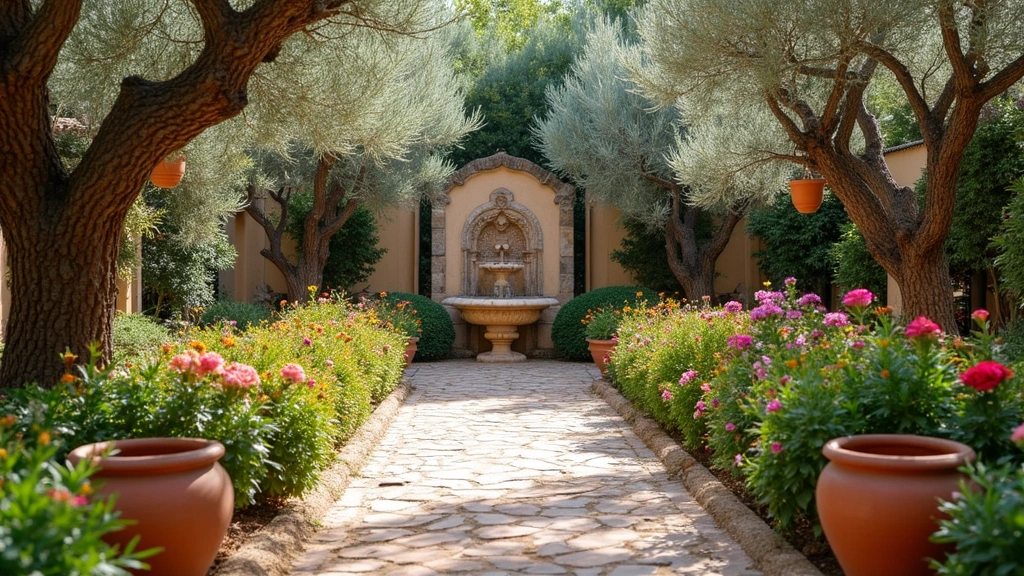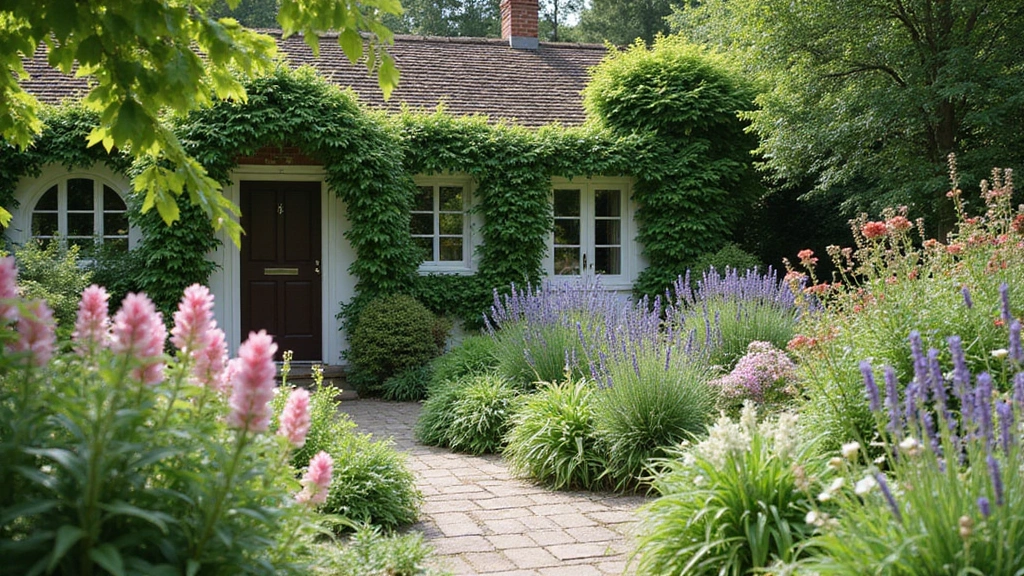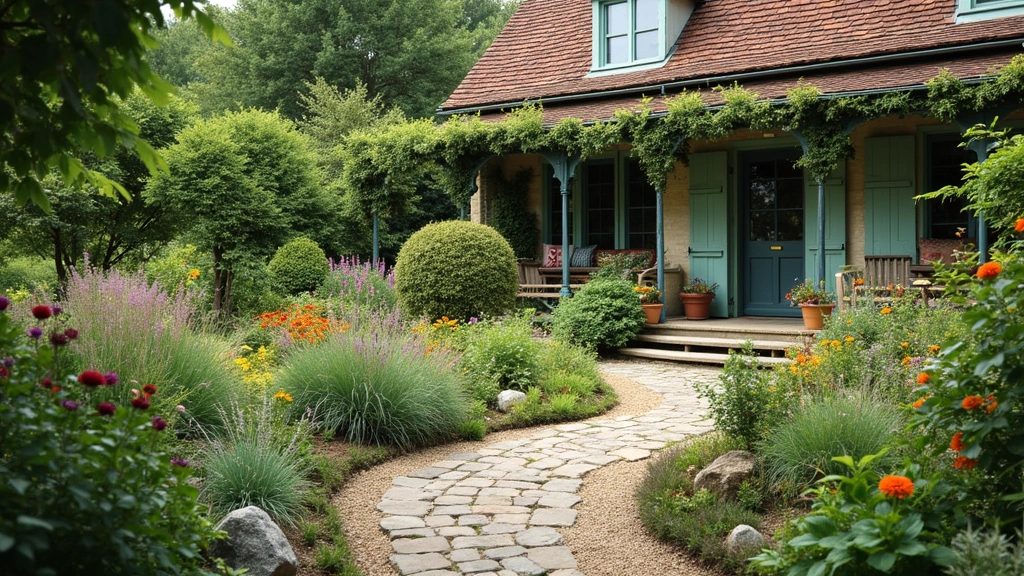Transforming your outdoor space into a serene cottage garden can provide an enchanting escape right in your backyard.
With blooming flowers, lush greenery, and cozy seating nooks, a cottage garden evokes warmth and charm. It’s a delightful way to connect with nature while creating a personal retreat. By incorporating seasonal flowers, unique planting tips, and rustic elements, you can design a garden that reflects your style and invites relaxation. Whether you’re a budding gardener or an expert looking for fresh inspiration, these tips will help craft a tranquil space that feels like home.
Get ready to dig in and discover the secrets to building your perfect garden paradise!
1. Embrace a Variety of Seasonal Flowers
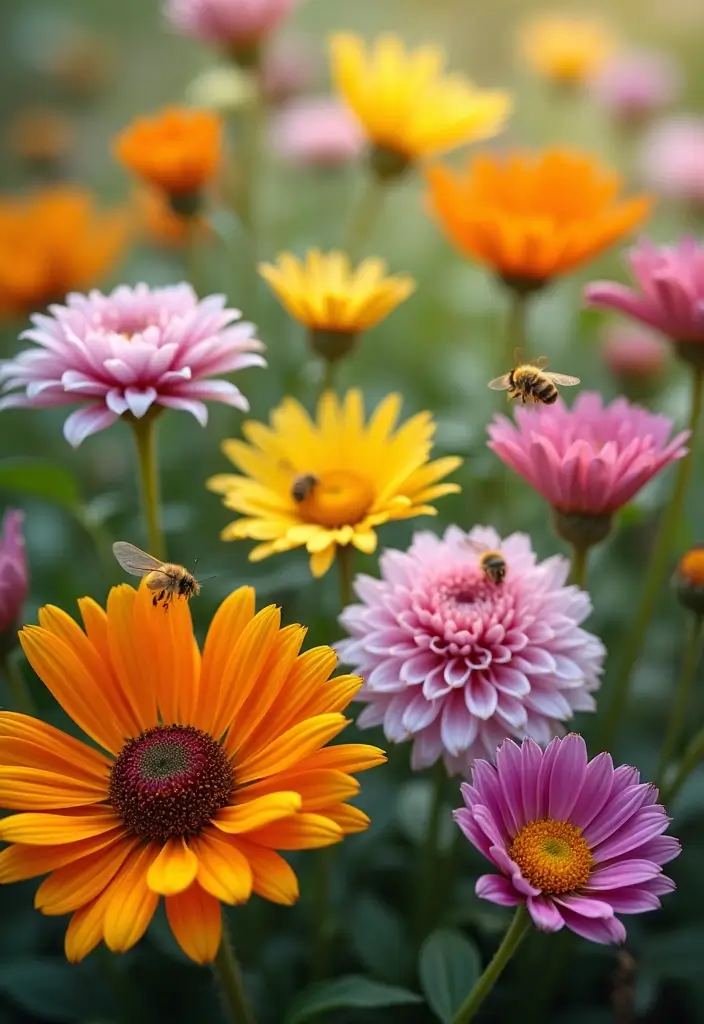
A vibrant mix of seasonal flowers can add life and color to your cottage garden throughout the year. Choosing flowers like daisies, sunflowers, and peonies in spring can bring joy and beauty during their blooming seasons. As seasons change, consider integrating asters, chrysanthemums, and sedums for fall, ensuring your garden stays lively and welcoming. Tall sunflowers can create a stunning backdrop, while delicate daisies add a touch of whimsy.
To get started on your colorful garden, you might find a flower seed assortment pack helpful. This pack includes a variety of flower seeds, such as forget-me-nots, marigolds, and zinnias, allowing you to enjoy diverse blooms throughout the seasons without the hassle of sourcing each type individually.
Additionally, having the right tools is essential for successful gardening. Consider investing in a garden planting tools set. This heavy-duty gardening toolkit comes with everything you need to easily plant and maintain your flowers, ensuring your garden thrives.
Tips:
– Group flowers by height for a more structured look.
– Incorporate perennials for lasting blooms alongside annuals for seasonal variety.
– Don’t forget to mix colors to keep your garden playful and inviting.
A vibrant display of color will attract pollinators like bees and butterflies, enhancing not just the beauty but also the ecosystem of your garden.
2. Create Cozy Seating Areas
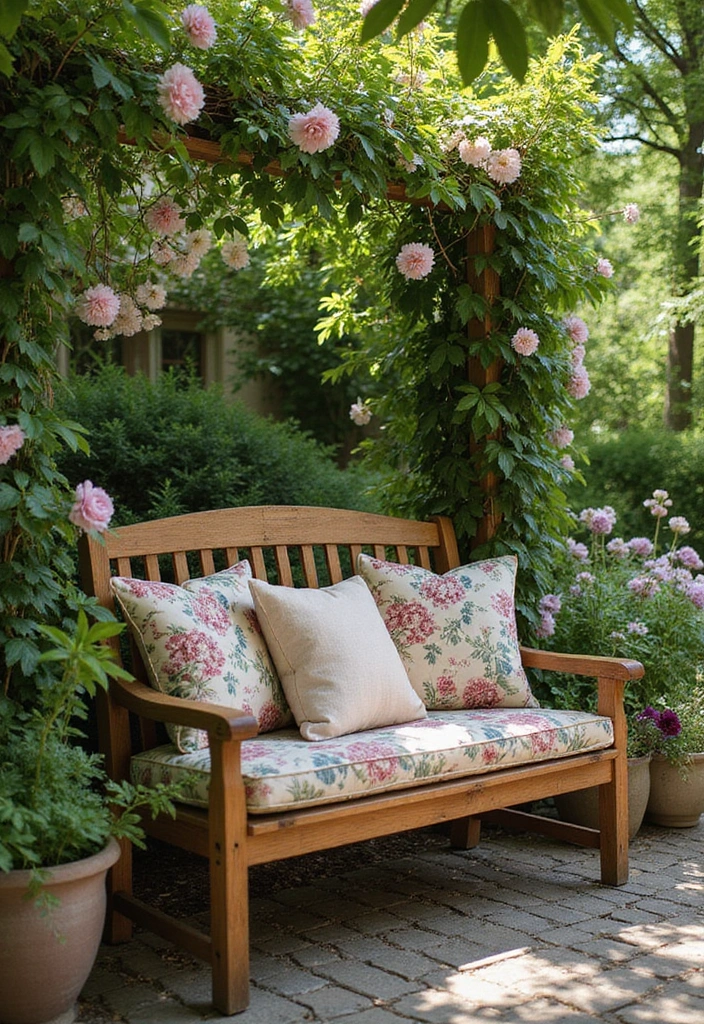
One of the best ways to enjoy your cottage garden is to carve out cozy seating areas. Choose a rustic wooden bench like the VINGLI 41″ rustic wooden wheel bench, which not only complements the charm of your garden but also offers a comfortable spot for two to relax. Position it near flowering bushes to create a charming nook where you can sip tea or read a book.
For additional comfort, consider adding floral print cushions such as the Greendale Home Fashions outdoor reversible 2-piece deep seat cushion set. These will enhance your seating area with a touch of style while ensuring you have a cozy place to sit for hours.
If you prefer something more portable, a couple of Garden Elements folding patio & lawn chairs can be a great option. With their comfortable design and rustic wooden armrests, they are perfect for enjoying the beauty of your garden, whether you’re hosting friends or taking a moment for yourself.
Considerations:
– Use natural materials that blend seamlessly with your garden.
– Surround seating with fragrant plants like lavender or jasmine for a soothing atmosphere.
– Incorporate shade structures like umbrellas or pergolas for sunny days.
These inviting spots will make your garden feel like a true retreat, perfect for enjoying nature’s beauty.
3. Mix Edibles with Ornamentals
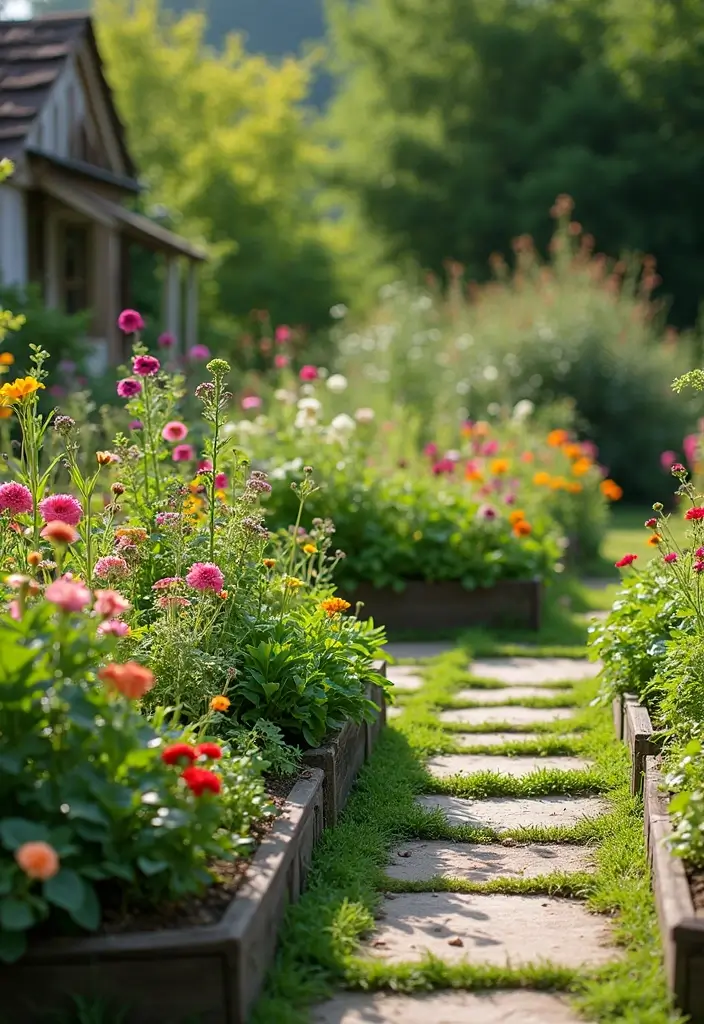
Why not blend beauty with practicality by incorporating edible plants into your garden? Herbs like rosemary, thyme, and basil can be equally decorative and delicious, adding aroma and texture. You can plant colorful vegetables like radishes and carrots in raised beds or borders. A great option for this is the raised garden bed kit, which provides an ideal space for your edibles while enhancing the visual appeal of your garden. This combination not only enhances aesthetics but also provides fresh ingredients for your kitchen.
To maximize space and create visual interest, consider using vertical gardening techniques. The vertical garden planter is perfect for growing strawberries, herbs, flowers, and vegetables in a compact way. Pairing colorful veggies with ornamental flowers will create an aesthetically pleasing look in your garden.
Don’t forget to label your herbs and veggies! Using garden labels for plants, like T-type tags, can help you maintain that rustic charm while making it easy to identify your plants.
This lovely mix of edibles and ornamentals makes your garden both functional and beautiful.
4. Establish Winding Paths
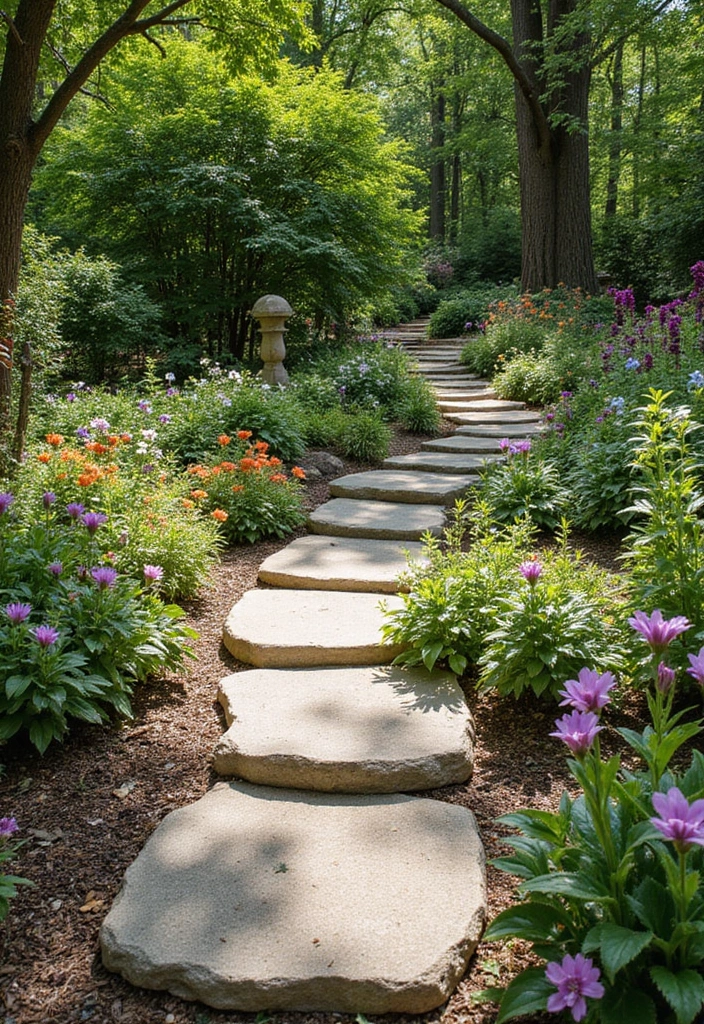
Winding paths in a cottage garden not only lead visitors through the space but also add a whimsical touch. Using materials like gravel, bricks, or stepping stones, you can create a meandering path that invites exploration. For instance, consider using Garden Stepping Stones to bring a playful element to your walkways. These stepping stones can connect different areas of your garden, leading to hidden seating spots or flowerbeds.
To enhance the aesthetic, you might line the paths with low-growing flowers or herbs, creating a lush border. If you prefer a more rustic feel, using reclaimed wood can add character to your design. Additionally, incorporating garden art along the path can provide visual interest and charm.
For those looking to create a solid base for their path, using gravel for pathways is an excellent choice. This 40 lbs of grey pea gravel not only looks attractive but also ensures proper drainage, which is essential for maintaining the health of your garden.
Finally, to keep everything neatly defined, consider adding some structure with a garden edging border. This flexible plastic edge border will help prevent soil from spilling onto your pathways and ensures that your garden beds stay tidy.
Make sure the path is wide enough for comfortable walking, around 2-3 feet, to create an engaging experience that draws people into the garden’s magic.
5. Add a Water Feature

A water feature can enhance both the visual appeal and tranquility of your cottage garden. Consider adding a small pond, birdbath, or even a bubbling fountain to create a soothing atmosphere. The sound of water can be incredibly calming, allowing you to unwind as you enjoy your garden space.
To make the most out of your water feature, think about surrounding it with moisture-loving plants like ferns and astilbes, which will help integrate it beautifully into your garden. For a practical and affordable option, the Solar Fountain Pump is an excellent choice. This solar-powered pump includes six nozzles and a 4ft water pipe, making it perfect for use in a birdbath, pond, or garden setting. It brings movement to the water, adding both visual interest and a relaxing sound.
When selecting a birdbath, consider the Birdbath with Stand. This stylish outdoor metal birdbath provides a lovely spot for birds to drink and bathe, which can attract local wildlife to your garden. Keeping it clean is essential to ensure it remains inviting for birds while helping to prevent algae growth.
Additionally, to enhance the overall look of your water feature, you might want to use natural stones for framing. The Natural Stone Garden Edging is a great option for creating a decorative border around your water feature. This easy-to-install no-dig landscape edging not only brings a finished look to your garden but also helps keep the area tidy.
This lovely addition not only beautifies your space but also supports local wildlife, offering a home for birds and beneficial insects. Enjoy the serene environment and the vibrant life your water feature can bring to your cottage garden!
6. Incorporate Climbing Plants

Climbing plants can add vertical interest and charm to your cottage garden.
Consider planting climbing roses, clematis, or honeysuckle on trellises or arbors. These plants can create a lovely backdrop against walls or fences, softening their appearance. Additionally, they provide excellent cover and create intimate spaces within your garden. To support your climbing plants effectively, you might want to check out this garden trellis. This versatile structure can be assembled in two sizes, making it perfect for various climbing plants such as roses or vines.
Climbing plant tips:
– Choose climbing plants that complement your existing flowers for a cohesive look.
– Ensure they have proper support to grow vertically without damaging other plants. Using a sturdy trellis will help maintain their trajectory.
– Regular pruning can help maintain their shape and encourage blooming. For that task, consider getting a pair of pruning shears. These clippers feature a sharp, rust-resistant steel blade that makes trimming and shaping a breeze.
If you’re looking to start your climbing plant collection, you can find a variety of options, such as this climbing plant seeds pack with 600+ mix climbing rose seeds. These heirloom seeds are perfect for planting outdoors and can provide long-blooming beauty to your garden.
Your garden will flourish with these beautiful, fragrant additions, enhancing the overall aesthetic of your cozy retreat.
7. Use Rustic Fencing

Rustic fencing can define your cottage garden’s boundaries while adding to its charm. Consider using wooden picket fences, like the Greenes Fence Deluxe Picket Wooden Fence, which offers a lovely aesthetic while providing structure to your garden. Alternatively, you might opt for willow fencing rolls, which blend seamlessly with the natural environment and create a warm, inviting feel. Natural stone walls are another excellent choice to achieve a rustic look.
This kind of fencing not only gives your garden definition but also adds character and warmth. You can even let climbing plants grow over the fence to enhance the natural look.
For a sustainable option, consider using repurposed materials. If you choose to go the wooden route, applying a coat of Varathane Premium Fast Dry Wood Stain in a soft, earthy tone will enhance the rustic feel while protecting the wood from the elements.
Be sure to include gates that match your fence design, leading into your enchanting retreat. A well-chosen fence will frame your garden beautifully, helping to create a private sanctuary.
8. Add Garden Art

Garden art can serve as delightful focal points within your cottage garden, adding both personality and charm. Consider incorporating whimsical sculptures like the Whimsical Garden Sculpture from Carruth Studio, which adds a touch of fun and can easily capture the interest of visitors. Additionally, decorative birdhouses, such as the Decorative Birdhouse by Glitzhome, can enhance the aesthetics of your garden while providing a home for local birds, making your outdoor space feel alive and inviting.
For a more immersive experience, charming wind chimes like the Charming Wind Chimes can add a soothing sound element, creating a serene atmosphere as they catch gentle breezes. Position these art pieces among the plants to create surprise elements that draw the eye. For an extra touch of whimsy, consider painting stones or creating mosaics to further enhance your garden’s character.
Art Ideas:
– Create a themed area with a specific style of art, like vintage or contemporary.
– Use local artists to find unique pieces that resonate with you.
– Rotate pieces seasonally to keep your garden feeling fresh.
Incorporating art into your garden will reflect your personality and create a more immersive experience. As you add these artistic touches, you’ll find that they not only beautify your space but also spark joy and conversation.
9. Plan for Year-Round Interest
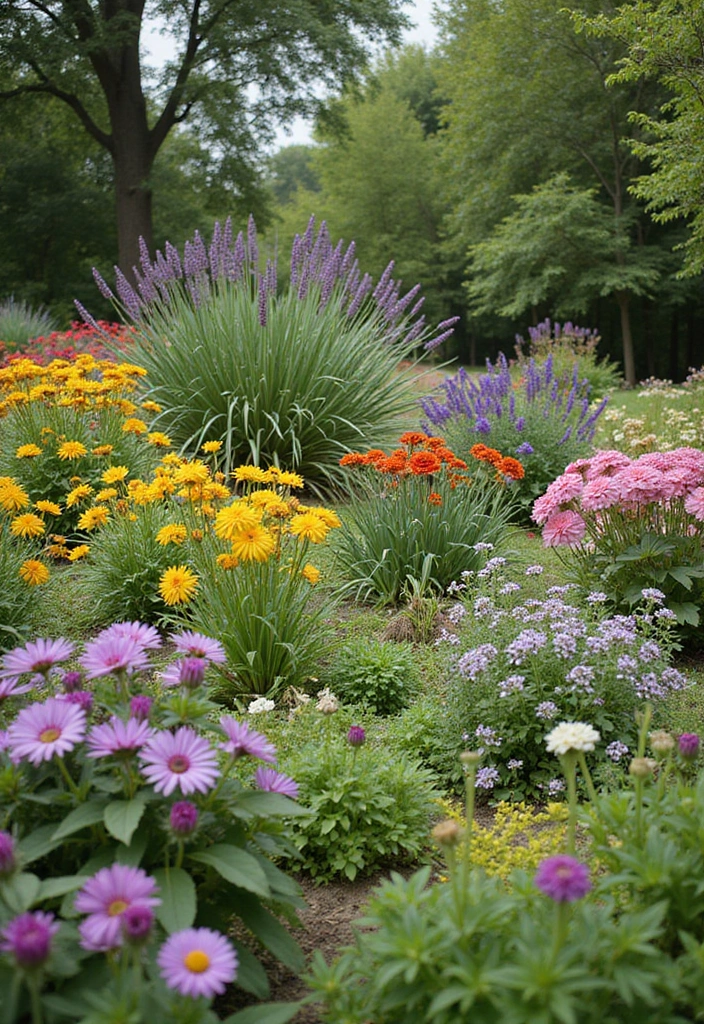
To maintain a beautiful garden throughout the seasons, careful planning is key. Choose a variety of plants that bloom at different times of the year. For example, spring bulbs like daffodils and tulips can be followed by summer blooms such as echinacea and hydrangeas. In the fall, consider adding ornamental grasses that sway in the wind and stay vibrant well into winter.
Year-Round Planning Tips:
– Layer plant heights from tall to short for visual interest.
– Include evergreens for structure during the colder months.
– Incorporate plants with interesting bark or form for winter aesthetics.
To help you with your gardening journey, the garden planting guide book offers valuable insights into selecting the right plants for year-round interest, ensuring your garden remains a feast for the eyes, no matter the season. Additionally, a reliable garden tool set can make the planting and maintenance of your diverse selections much easier. With the right tools at your disposal, you’ll find it simpler to achieve and sustain the cozy retreat you envision.
10. Create a Natural Pathway with Mulch
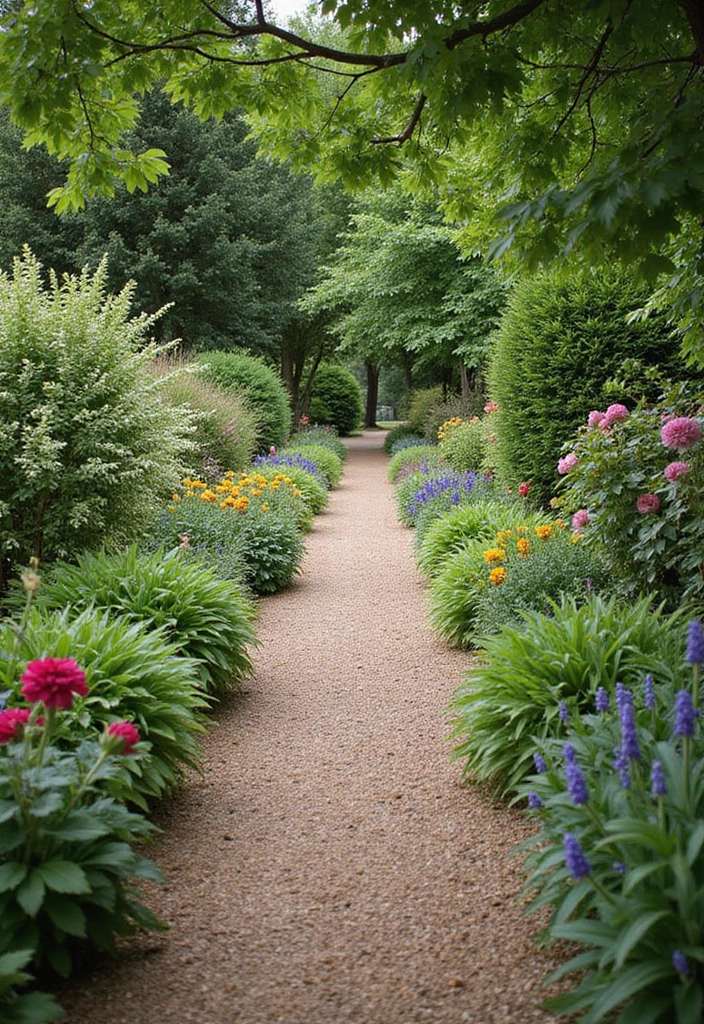
Using mulch in your garden paths can provide a natural look while keeping weeds at bay. Organic mulch options like 100% natural pine bark mulch nuggets or straw mulch blend beautifully with the garden and can improve soil health. This technique is not just functional; it also adds texture and warmth to your outdoor space. Additionally, a mulched path can be softer underfoot, making your garden more inviting.
Mulch path tips:
– Apply mulch 3-4 inches thick for effective weed control.
– Choose mulch that complements your garden’s colors. The natural pine bark mulch nuggets provide a rich, dark color that enhances a variety of plant hues.
– Replenish mulch as needed to maintain its appearance. Using a tool like the VEVOR compost spreader can help distribute your mulch evenly and efficiently, ensuring a well-maintained look.
This approach marries functionality with beauty, enhancing your garden’s overall appeal.
11. Incorporate Fairy Lights

Fairy lights can add a magical ambiance to your cottage garden, especially in the evenings. Stringing lights along fences, trees, or over seating areas creates a warm and welcoming atmosphere. For an eco-friendly option, consider using solar-powered fairy lights that come with 320 LEDs and 8 different modes. Wrapping them around branches or placing them in mason jars will give your garden an enchanting glow.
To enhance the rustic vibe of your outdoor space, you might also want to add rustic lanterns. These battery-powered lanterns provide flickering flame effects and can easily be hung around your garden, adding a charming light source that complements your fairy lights.
For those who prefer a plug-in option, warm white LED string lights are perfect for illuminating pathways or draping over seating areas. With 100 LEDs and 8 modes, they can create a cozy feel that invites guests to linger.
These charming additions will allow you to enjoy your garden long after the sun sets, making it perfect for evening gatherings.
12. Grow a Herbal Corner
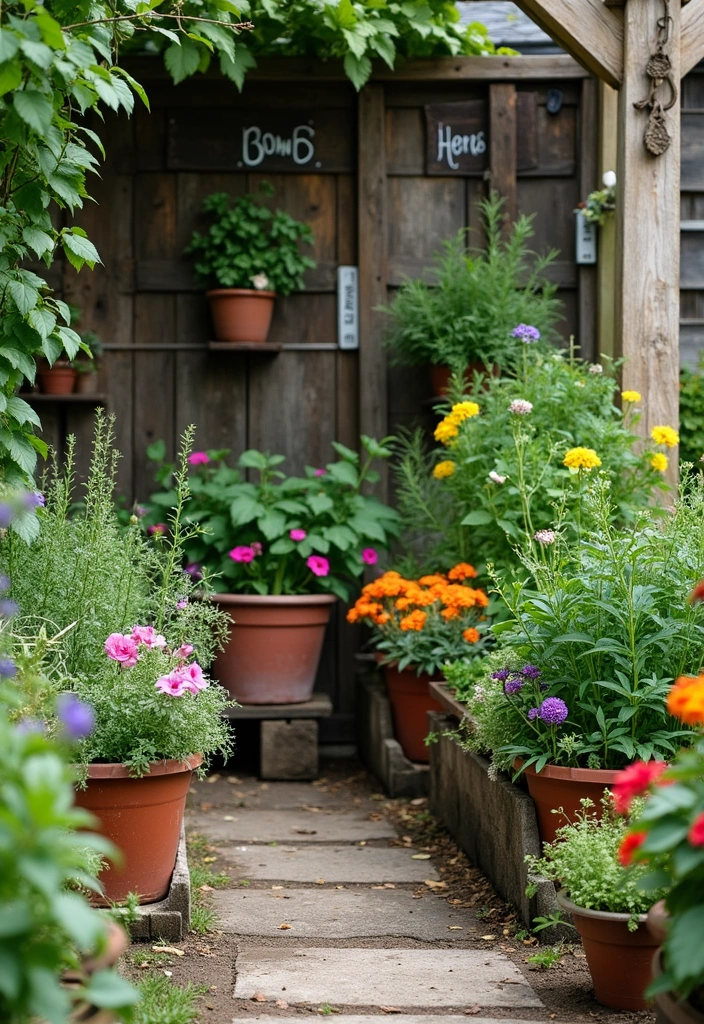
Creating a dedicated herbal corner in your garden can be both practical and beautiful. Plant a variety of culinary herbs like basil, mint, and parsley, along with fragrant ones like rosemary and lavender. This corner can be a sensory delight, inviting your senses with their scents, textures, and colors. Consider using a small trellis for climbing herbs or flowers to add height and interest. A great option for this is the small trellis for climbing plants, which provides support and enhances the visual appeal of your garden.
Herb Corner Tips:
– Organize herbs by height and use pots for easy access. A helpful tool for this is the herb garden starter kit, which includes a hydroponics growing system designed for easy, efficient herb cultivation right in your kitchen.
– Incorporate decorative markers to label each type of herb. Consider using decorative plant markers to keep your herbs organized and add a charming touch to your garden.
– Keep it close to your kitchen for convenient harvesting.
This not only beautifies your garden but also enhances your cooking, bringing fresh flavors right to your meals.
13. Choose a Color Palette

Establishing a cohesive color palette can dramatically enhance your cottage garden’s aesthetic. Selecting a harmonious combination of colors can create a serene environment. You might opt for soft pastels for a romantic feel or bold, vibrant hues for a striking look. To aid in your color selection, consider using a color wheel for artists to find complementary or analogous colors that will elevate your garden’s design.
When planning your garden layout, it’s also important to think about seasonal changes in color. Make sure that the foliage colors balance the flower hues for added depth. A great resource for this is the book how to design a garden: create and maintain your dream garden, which can provide you with valuable insights on creating a cohesive look throughout the seasons.
Additionally, you could experiment with monochromatic themes for a chic look. For more inspiration, check out the pocket complete color harmony, which offers over 1,500 color palettes tailored for designers, artists, and gardeners alike. This careful consideration of color will result in a visually appealing and organized garden space.
14. Utilize Container Gardening
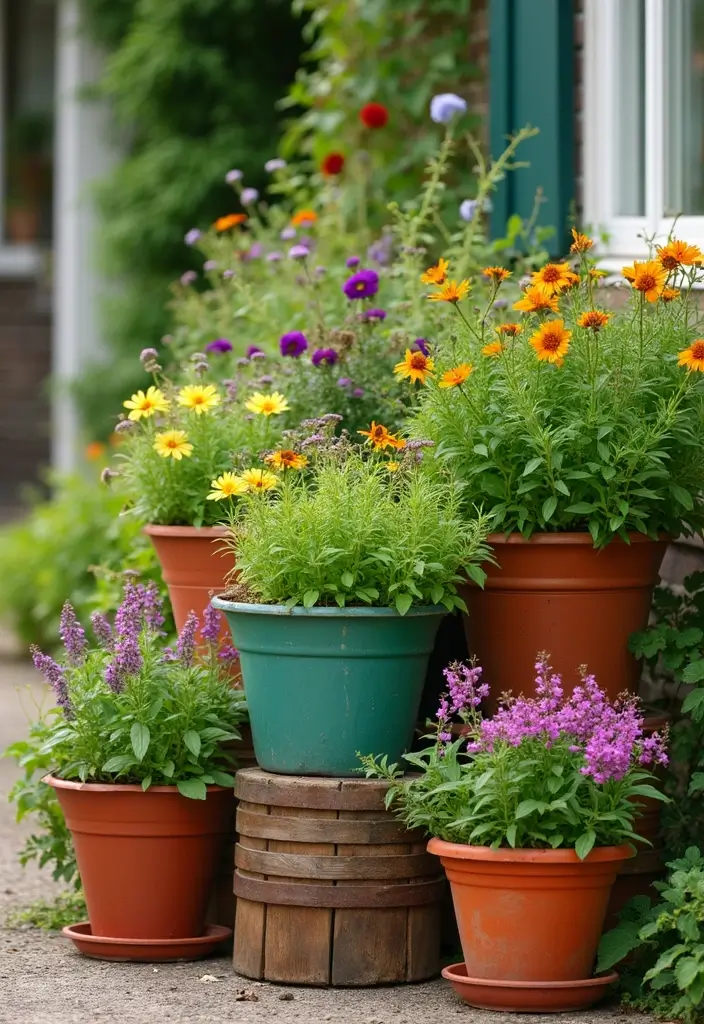
Container gardening can be an excellent way to maximize small spaces while adding beauty to your cottage garden. Using a variety of pots and containers, such as self-watering planters, you can effortlessly grow seasonal flowers, herbs, and even small vegetables. These pots make maintenance easier by providing a consistent water supply, allowing you more time to enjoy your garden.
This method allows for flexibility in arrangement and design, enabling you to change things up whenever you feel inspired. Grouping containers together can create impactful visual displays. Opt for different heights with your choices, perhaps incorporating decorative plant pots that add a rustic touch while showcasing your plants beautifully.
Additionally, organizing your gardening tools can simplify your planting process. A gardening tool set with a selection of durable hand tools is ideal for all your container gardening needs, making it easier to tend to your plants and keep them healthy.
Containers can be a fantastic way to bring greenery to patios or balconies, ensuring your garden feels alive and vibrant.
A cozy cottage garden is just a pot away! Embrace container gardening to transform your space—mix heights and colors for a stunning display that evolves with your seasonal inspiration.
15. Incorporate Seasonal Decor

Seasonal decor can enhance the charm and theme of your cottage garden throughout the year. From summer blooms to autumn leaves, consider adding decorative elements that reflect the current season. For instance, you can incorporate pumpkins in the fall, evergreen wreaths in winter, and vibrant flower arrangements in spring. Seasonal decor can also involve festive lighting or themed garden ornaments.
To make decorating even easier, consider using seasonal garden flags. This set includes 12 double-sided flags that cover all seasons, allowing you to switch decorations regularly and keep your garden feeling fresh.
You might also want to encourage local wildlife by adding a bird feeder with seasonal themes. This environmentally friendly option is made from recycled plastic and features a design that invites birds to your garden, aligning perfectly with your seasonal decor efforts.
Finally, for those cozy evenings outdoors, outdoor string lights can create a warm and inviting atmosphere. These vintage-style bulbs are waterproof, making them ideal for year-round use, and they add a magical touch to your outdoor space.
Incorporating these items not only keeps your garden engaging but also helps you celebrate the changing seasons in style.
16. Establish a Compost Area
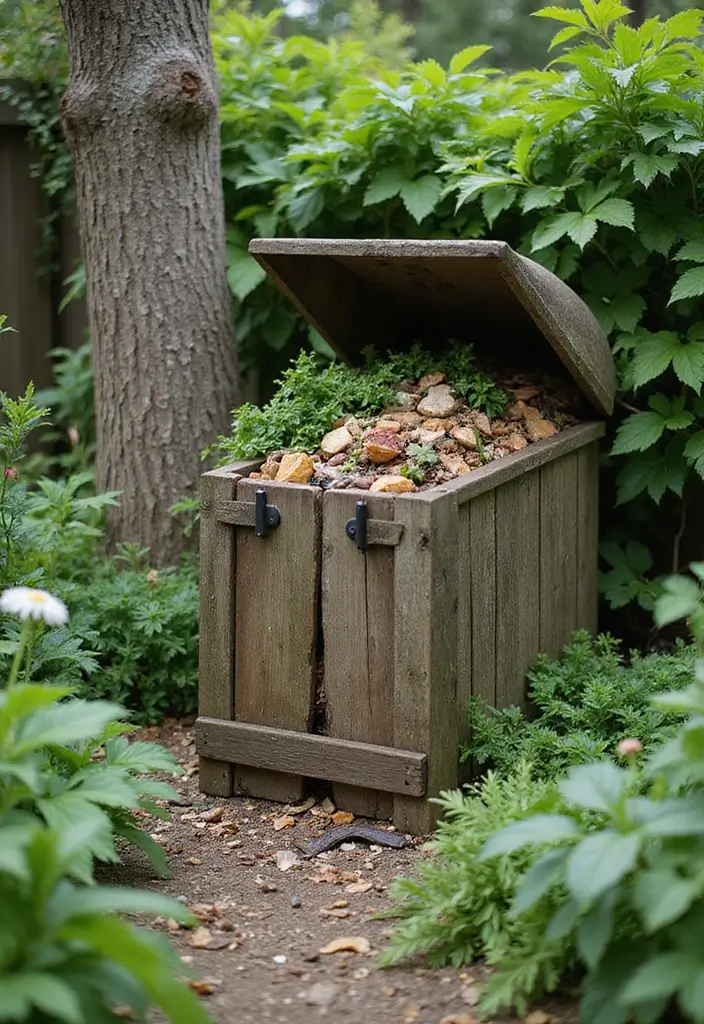
Creating a compost area can be an eco-friendly addition to your cottage garden. Not only does it help reduce waste, but it also provides nutrient-rich soil for your plants. Choose a corner of your garden to set up a compost bin or pile, ensuring it’s easily accessible. For a sleek and functional option, consider the Utopia Kitchen compost bin, which features a lid and a spare charcoal filter to keep odors at bay.
Layer green materials like vegetable scraps with brown materials like dried leaves for optimal results. To enhance the decomposition process, turning your compost regularly is essential. Using a compost aerator can make this task easier and more efficient, allowing for better aeration and faster decomposition.
Additionally, monitoring the temperature of your compost can help you achieve the best results. A compost thermometer offers a convenient way to keep track of the internal temperature, ensuring your compost is breaking down properly.
Your garden will thrive with the benefits of homemade compost, enhancing its health and vibrancy.
17. Plan for Pollinators
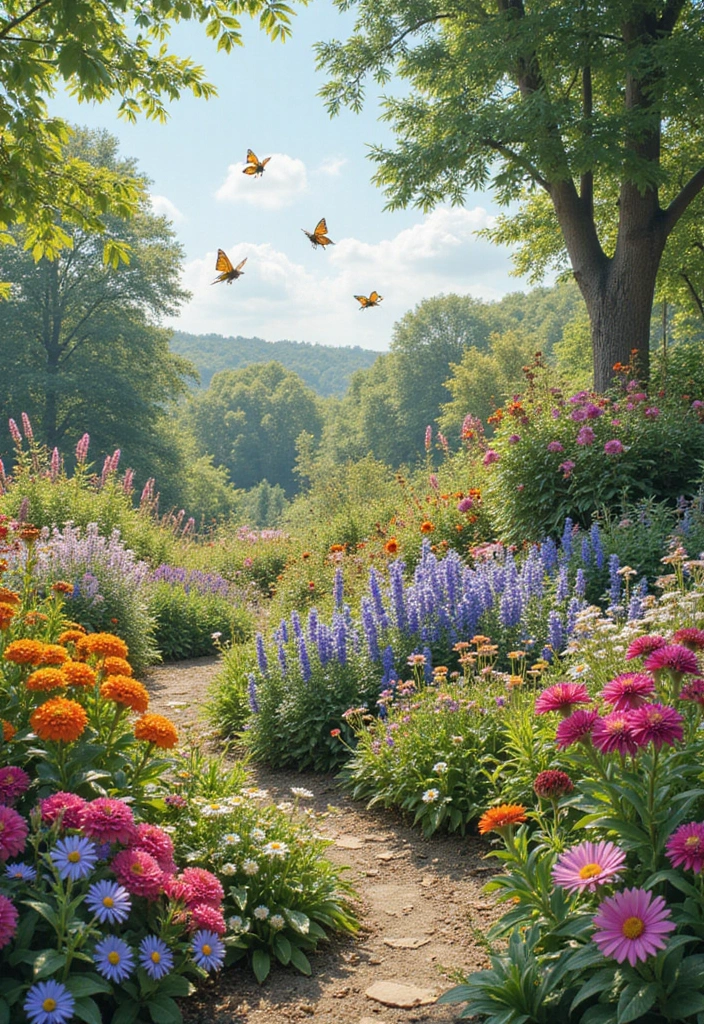
Creating a cottage garden that attracts pollinators can enhance biodiversity and benefit your plants. To support this lively ecosystem, integrate a variety of flowering plants that bloom at different times, providing food sources for bees, butterflies, and other pollinators. Avoid using pesticides, as they can harm these beneficial insects. Additionally, providing water sources, such as shallow dishes or birdbaths, will help keep them hydrated.
For instance, consider adding a birdbath for garden. This elegant piece not only serves as a water source for pollinators but also adds charm to your outdoor space.
Implementing some pollinator-friendly tips can further enhance your garden’s appeal. Plant in clusters to make it easier for pollinators to find flowers, and include native plants that are well-suited to your region. A great way to attract a variety of pollinators is to use the pollinator garden seed mix, which contains 18 varieties of non-GMO wildflower seeds, ensuring a colorful display throughout the growing season.
Finally, consider creating shelter for insects with small brush piles or undisturbed areas. A practical solution is to incorporate an insect hotel. This natural wooden structure offers a safe haven for ladybugs, lacewings, butterflies, and bees, encouraging them to take up residence in your garden.
With these thoughtful additions, your garden will thrive with the lively presence of pollinators, creating a vibrant ecosystem that benefits both you and your plants.
18. Use Ground Covers
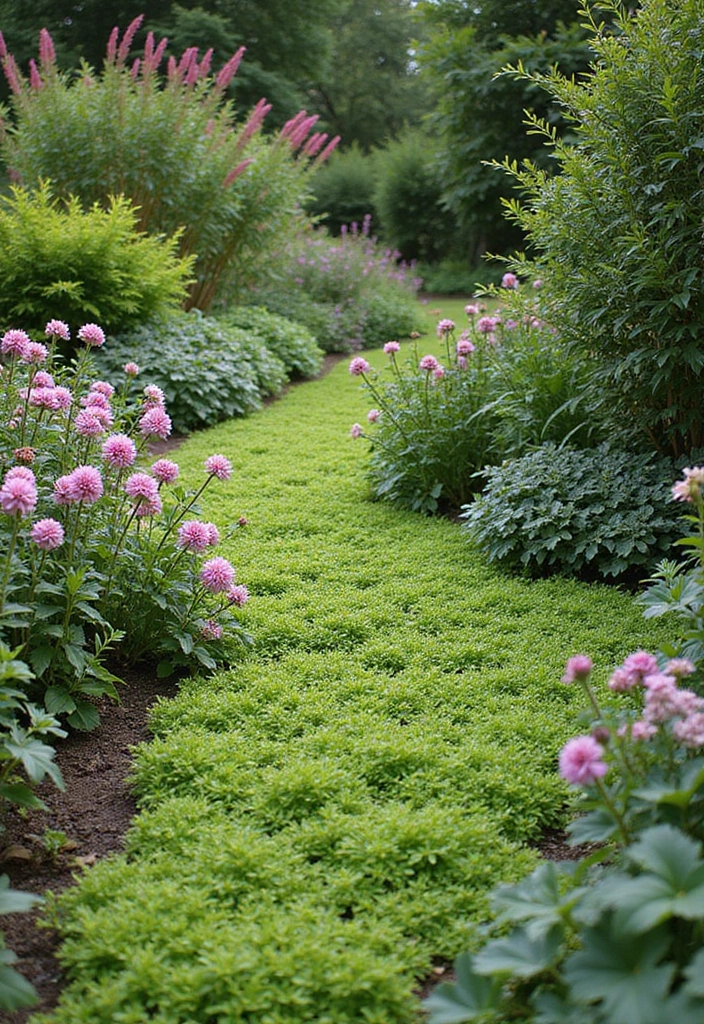
Ground covers are an excellent way to prevent weeds while adding beauty to your garden. Plants like creeping thyme can create a lush carpet effect that complements taller plants. This non-GMO heirloom variety not only beautifies your space but also helps retain soil moisture, making it a smart choice for maintaining a healthy garden environment.
For those tricky spots where grass may struggle, consider using ajuga (bugleweed). This perennial plant, with its striking lavender flowers, offers an appealing backdrop for your garden while filling in gaps effectively.
Additionally, if you’re looking for a unique touch, a moss garden starter kit with mixed mosses can add a soft, natural texture to your garden design. Moss not only looks great but also plays a role in retaining soil moisture.
Ground cover tips:
– Choose plants that suit your garden’s sunlight conditions.
– Mix different types for visual interest.
– Keep them well-trimmed to prevent overgrowth into other plant areas.
This strategy enhances your garden’s health while keeping maintenance easy and manageable.
19. Highlight Unique Foliage
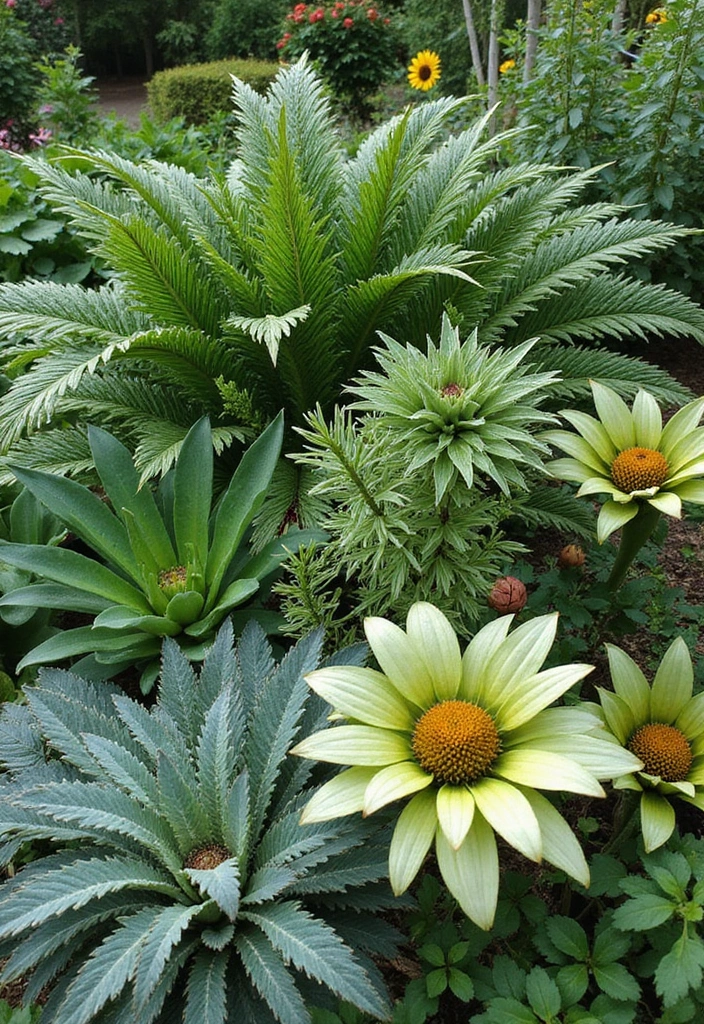
Incorporating plants with unique foliage can enhance your cottage garden’s visual appeal. Consider adding Heuchera plants with their colorful leaves, which can bring a vibrant touch even when flowers are not in bloom. Their striking foliage makes them excellent candidates for adding depth and interest to your garden.
Another fantastic option is lamb’s ear plants, known for their soft, velvety texture. This unique foliage creates a wonderful contrast with other plants and can make your garden feel inviting and cozy.
Don’t forget to include hosta plants, which provide lush greenery and can thrive in various light conditions. Their large leaves add an impressive backdrop to smaller plants, ensuring your garden remains visually appealing throughout the seasons.
Mixing these foliage colors and textures will create a lively atmosphere. Here are some foliage tips to keep in mind:
– Use contrasting foliage to highlight different plants.
– Layer shorter plants in front of taller ones for added dimension.
– Choose foliage that remains attractive year-round.
Highlighting unique foliage, such as Heuchera, lamb’s ear, and hostas, will ensure your cottage garden remains engaging all year round.
20. Plant for Fragrance
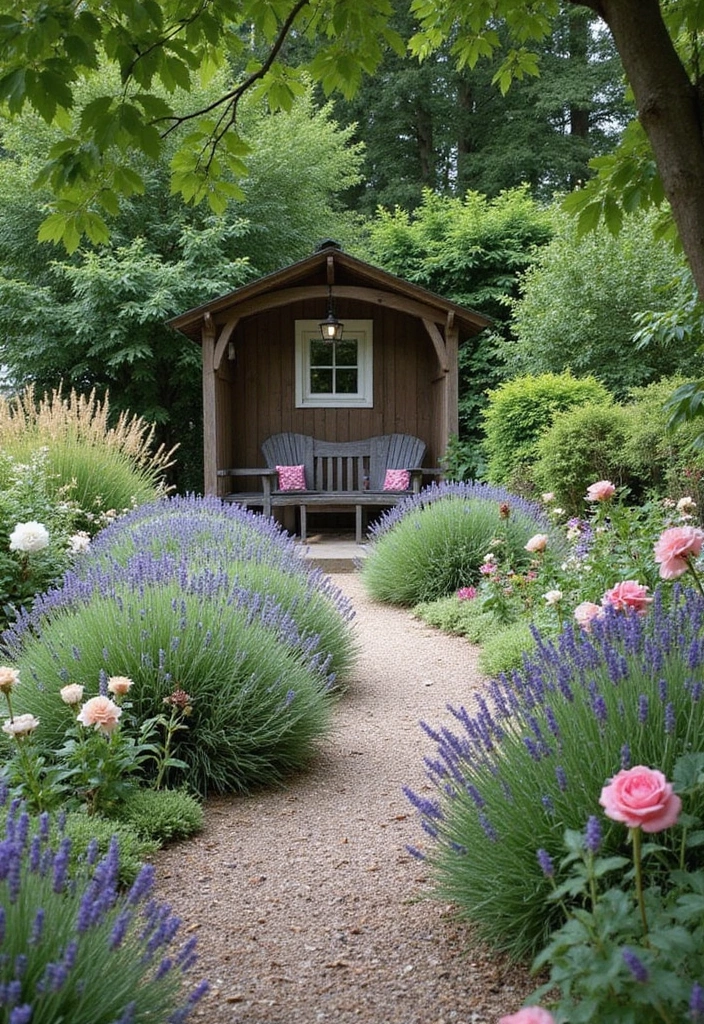
Creating a fragrant garden adds another sensory layer to your outdoor retreat. Integrate plants with captivating scents such as lavender, mint, or roses. Planting herbs like basil and cilantro not only enhances fragrance but also serves culinary purposes. Position fragrant plants around seating areas to elevate your garden experience.
One great way to maintain that lovely scent indoors is by using an essential oil diffuser. The ASAKUKI Essential Oil Diffuser not only disperses soothing aromas throughout your space but also features a remote control and multiple LED colors to create an inviting ambiance.
For a touch of warmth and comfort, consider adding scented candles like the Chesapeake Bay Candle Scented Candle in Peace + Tranquility. Its cashmere jasmine fragrance will wrap you in soothing scents as you relax in your garden oasis.
If you’re looking to enhance both your garden and your kitchen, an herb garden starter kit can be a perfect addition. This kit includes non-toxic, BPA-free pots, organic seeds, and everything you need to grow your own fragrant herbs right at home. Imagine snipping fresh basil or cilantro for your meals while enjoying their delightful scents in your garden.
Fragrance Tips:
– Choose plants that bloom at different times for year-round scent.
– Plant in areas where breezes can carry the fragrance.
– Incorporate scented elements like candles or essential oil diffusers for a complete sensory experience.
A fragrant garden will be inviting and soothing, enhancing your outdoor enjoyment.
21. Implement Seasonal Themes
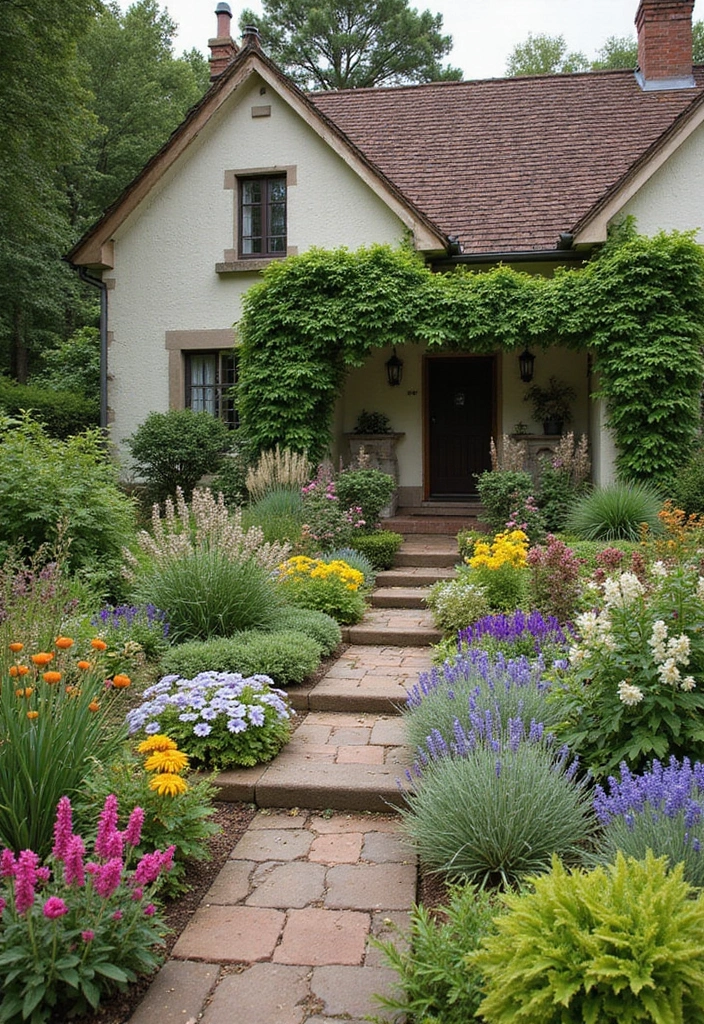
Creating seasonal themes can keep your garden fresh and engaging. Consider changing the décor, plants, and arrangements according to the seasons. In spring, focus on pastel colors and bulbs, which can easily be achieved with an assorted flower bulbs for all seasons that attract bees, butterflies, and hummingbirds, adding life to your garden. In summer, use vibrant blooms; in autumn, introduce rich oranges and deep reds with pumpkins, using seasonal decorations like the seasonal garden decor set featuring charming metal pumpkin yard stakes. For winter, accent with evergreen plants that can withstand the cold.
This way, your garden retains interest and excitement all year round.
Seasonal theme tips:
– Keep a journal of seasonal changes for planning, which can be made easier with the Garden Journal for Seasonal Planning. This guided notebook helps track your garden’s progress over the seasons.
– Rotate décor items to reflect the seasons.
– Engage family and friends by hosting seasonal garden parties.
This approach will keep your garden lively and make you look forward to each new season.
22. Focus on Organic Practices
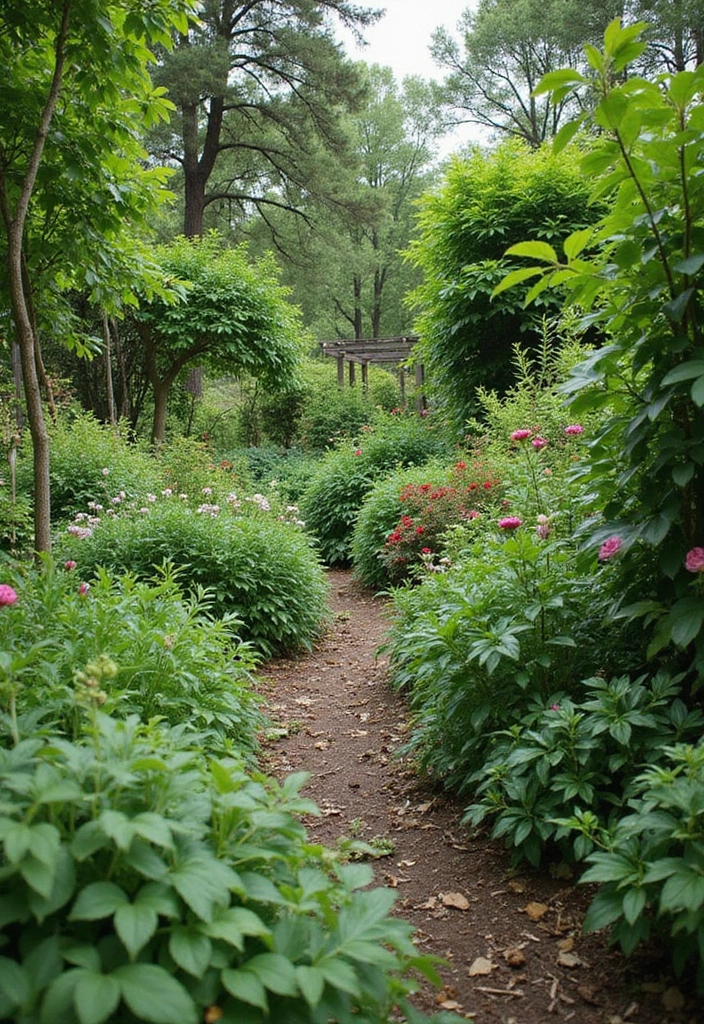
Embracing organic gardening practices can benefit both your plants and the environment. By avoiding synthetic pesticides and fertilizers and opting for natural alternatives, you create a healthier garden while also attracting beneficial insects. For instance, using organic compost can enrich your soil, providing essential nutrients to your plants and enhancing their growth.
In addition, consider employing natural pest deterrents like Neem Oil Insecticide. This multi-purpose solution not only protects your plants from pests but is also safe for the environment, making it a perfect fit for your organic gardening journey.
To further enhance your garden, focus on practices such as crop rotation, companion planting, and mulching to reduce weeds and promote biodiversity. A helpful resource for companion planting is the Companion Planting Guide Book, which provides valuable insights into which plants thrive together and how to maximize your garden’s potential.
By committing to organic gardening techniques and utilizing these products, you cultivate vibrant plants while fostering a sustainable environment.
23. Create a Children’s Garden

Involving children in gardening can be both educational and fun. Designing a special area for kids with colorful flowers, fun sculptures, and easy-to-grow plants can spark their interest in nature. To make this experience even more enjoyable, consider using a children’s gardening tools set. These tools are designed with sturdy wooden handles and perfect for small hands, encouraging kids to dig, plant seeds, and help care for their own garden.
Including activities such as creating a small vegetable patch can foster a sense of responsibility and appreciation for nature. For the flower aspect, bring in colorful flower seed packets, which offer a variety of flowers that are easy for children to grow. This not only enhances the beauty of your garden but also provides a hands-on learning experience as they observe the plants grow.
To add a touch of magic, incorporate themes like fairies or animals with decorative elements. A fun way to achieve this is through garden decorations, which include banners and garlands perfect for a fairy or animal theme. These elements can ignite their imagination and make gardening feel like an enchanting adventure.
This approach not only beautifies your garden but also creates lasting memories.
A children’s garden is a magical gateway to nature – where every bloom excites curiosity, and every seed planted is a lesson in care and responsibility.
24. Develop a Shade Garden
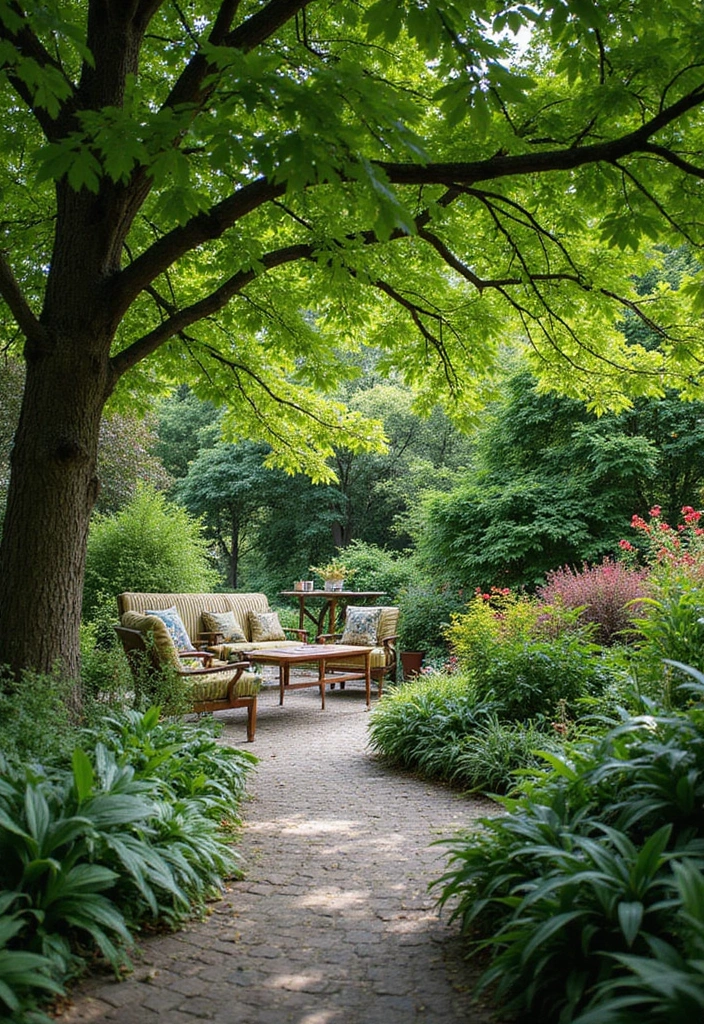
If your garden has shaded areas, you can create a beautiful shade garden filled with unique plants. Choose shade-loving plants like hostas, ferns, and astilbes that thrive under trees or structures. For a well-rounded selection, consider using Beth Chatto’s Shade Garden: Shade-Loving Plants for Year-Round Interest, which offers great insights into selecting the right plants. Incorporating a variety of textures and colors will help maintain visual interest in your garden.
To define the space and enhance its rustic feel, adding natural elements like stones or logs can create boundaries. You might find the EasyFlex No-Dig Landscape Edging particularly useful for establishing a decorative garden border while providing a neat finish to your shade garden.
Consider the amount of sunlight different areas receive throughout the day and layer your plants by height and richness of foliage for a dynamic look. To enjoy your shaded sanctuary, adding a small seating area is essential. A lovely choice for this could be the Outdoor Bench Garden Bench, which is weatherproof and perfect for relaxing in your peaceful retreat.
These areas become tranquil spots in your garden, offering a different vibe and a cozy place to unwind.
25. Use Raised Beds
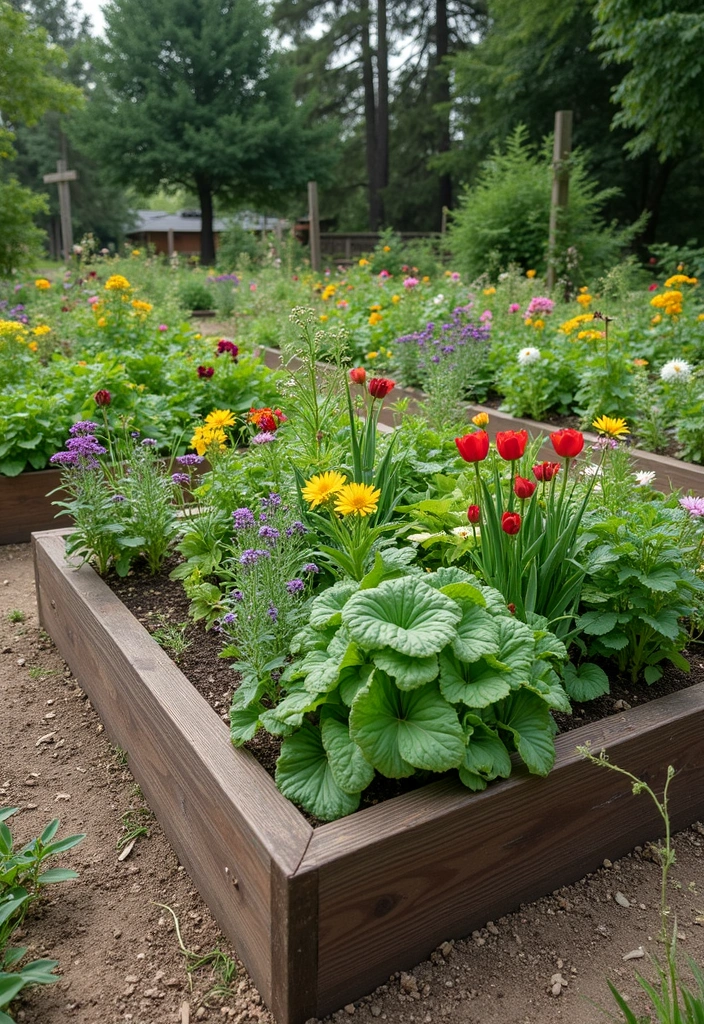
Raised beds can add structure and facilitate easier gardening while enhancing your cottage garden’s aesthetics. They provide improved drainage and soil conditions, making them ideal for growing flowers and vegetables. Construct them using natural materials like wood or stone to ensure they blend in with your garden. You can stagger multiple beds to create visual interest.
To get you started, consider the Wooden Raised Garden Bed Kit, which offers a sturdy and attractive option for your plants. Filling your raised beds with a mix of soil and compost is essential for maximum nutrients. Using a quality product like Organic Compost for Gardening can enhance the soil quality and promote healthy plant growth.
Create pathways between the beds for easy access, and to maximize space, you can plant vertically on trellises attached to the beds. The Garden Trellis for Climbing Plants is a lightweight option that works well for supporting climbing varieties of flowers and vegetables, adding both functionality and beauty to your outdoor space.
These beds elevate your gardening experience while adding beauty and organization to your outdoor space.
26. Create a Wildlife Habitat
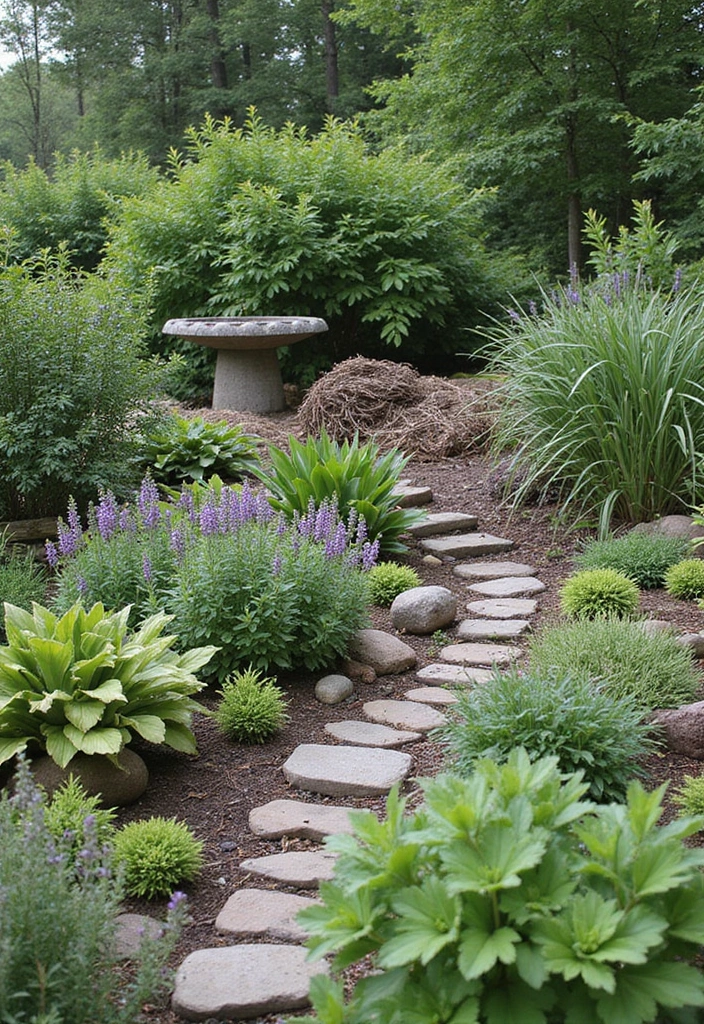
Designing your garden to serve as a wildlife habitat can enrich the ecosystem and enhance biodiversity. By incorporating a variety of plants, providing shelter with native shrubs, and creating water sources like birdbaths or small ponds, you can attract a host of beneficial creatures. Avoid using pesticides to protect the valuable insects and birds that help your garden thrive. Additionally, consider setting aside part of your garden as a wild area with native plants to support local wildlife.
One great way to attract a diverse range of species is by using a native plant seed mix. This California wildflower mixture includes over 7,000 native seeds, which can help attract butterflies and hummingbirds, enriching the biodiversity in your garden.
To further support your feathered friends, having a reliable food source is essential. A bird feeder filled with farmer’s delight wild bird food is a perfect way to ensure that you have a variety of birds visiting. This particular blend, with a hint of cherry flavor, will surely entice them to stop by frequently.
Moreover, to keep your garden ecosystem balanced, consider installing a bat house. This wooden bat house can attract bats that play a vital role in controlling insect populations, including mosquitoes. With a proven design, it increases your chances of hosting these beneficial creatures.
These practices foster a thriving ecosystem while allowing you to enjoy the beauty of nature.
A thriving cottage garden design isn’t just for you – it’s a sanctuary for wildlife! Create a cozy retreat that invites nature to flourish and watch your garden come alive with vibrant biodiversity.
27. Keep a Garden Journal
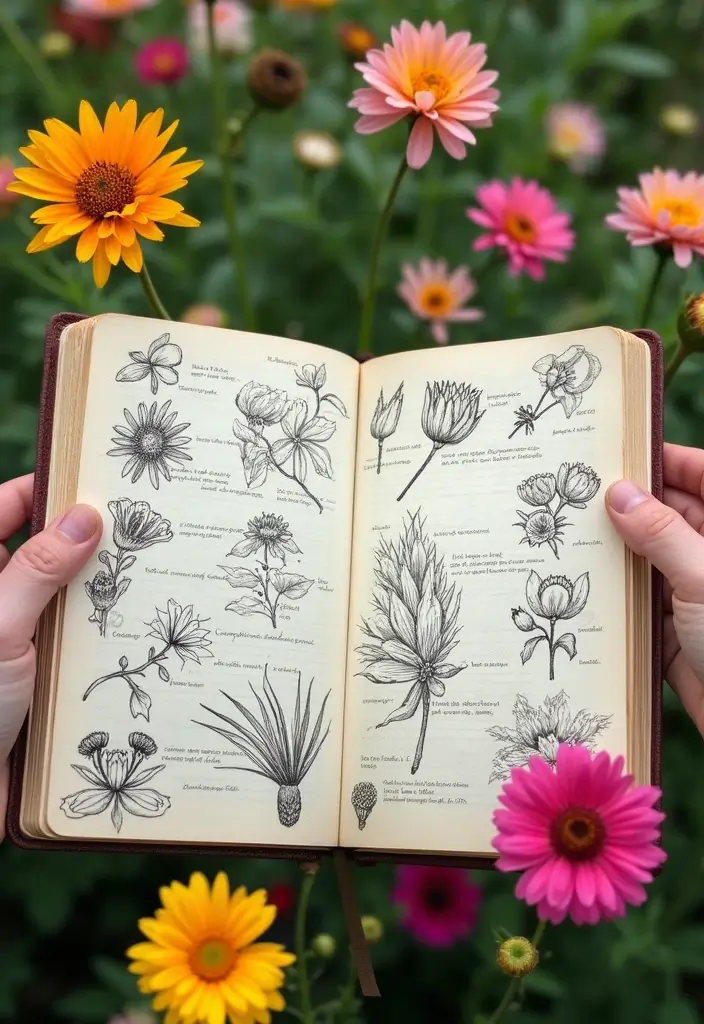
Maintaining a garden journal can be a rewarding practice that helps track your gardening journey. By logging the plants you’ve added, their blooming times, and any changes to your garden layout, you create a valuable record of your gardening experience. You can also jot down notes on weather patterns, pest issues, or what worked well and what didn’t. Including sketches or photos will allow you to capture your garden’s evolution over time.
To make this practice even more enjoyable and organized, consider the Clever Fox Gardener’s Journal – Guided Gardening Notebook. This 5-year garden log book is designed for beginners and helps you document everything from planting vegetables to flowering herbs, making it easier to reflect on your progress.
If you prefer a more structured approach to planning, the Clever Fox Gardener’s Journal – Gardening Planner with Calendar is another great option. It combines a calendar with guided sections that encourage you to set gardening goals while keeping track of your planting schedule.
Here are some journal tips to enhance your experience:
– Set aside time weekly or monthly for journaling.
– Use it not just for plans but also for inspiration.
– Review it at the end of the season to plan for the next year.
This practice enriches your gardening journey, allowing you to learn and grow year after year.
28. Celebrate Your Garden
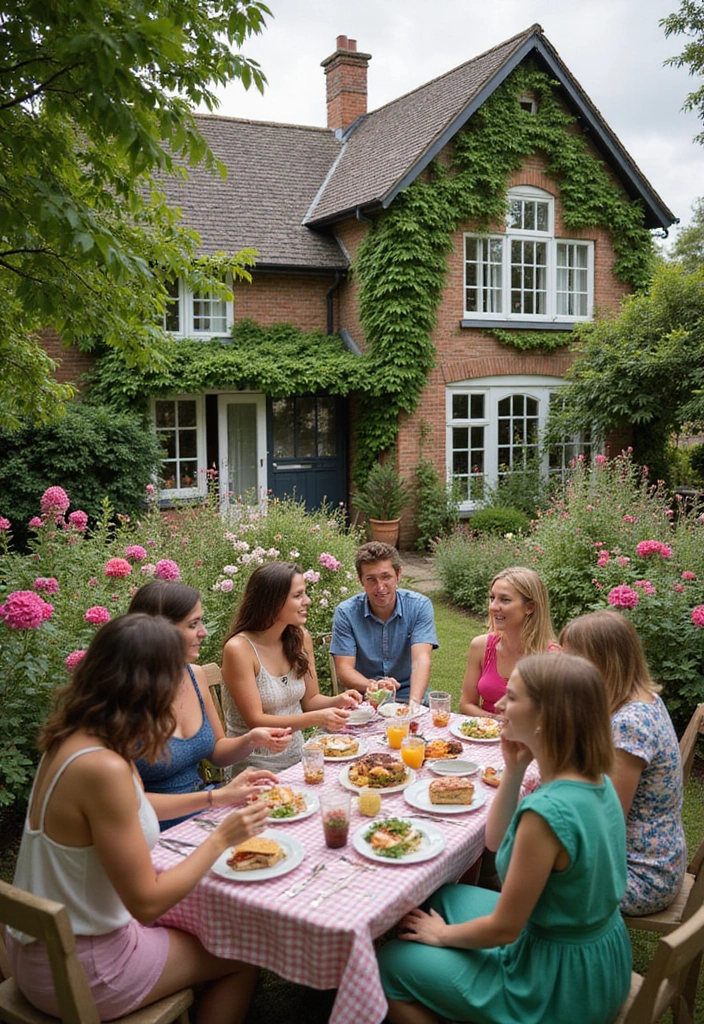
Finally, take the time to celebrate your garden! Host gatherings with friends and family, inviting them to enjoy the beauty of your labor. Seasonal parties or garden tours can also bring more appreciation of your outdoor space. This not only honors your hard work but also creates joyful memories in your cozy retreat.
To enhance your celebration, consider adding outdoor string lights to create a warm and inviting atmosphere as dusk falls. With 100 feet of lights featuring 52 shatterproof vintage Edison bulbs, these waterproof string lights will beautifully illuminate your gatherings on the porch, deck, or in the garden.
For memorable meals, set up an inviting dining area with a portable outdoor dining set. This 5-piece acacia wood set includes chairs with wheels, making it easy to move around and accommodate your guests comfortably, whether you’re enjoying a casual brunch or a festive dinner under the stars.
Don’t forget about the decor! Add a touch of whimsy with garden party decorations. A flower banner or wildflower garland can enhance the enchanting vibe of your garden space, making every occasion feel special.
Your cottage garden is not just a collection of plants; it’s a place of beauty and community. Enjoy every moment!
Conclusion
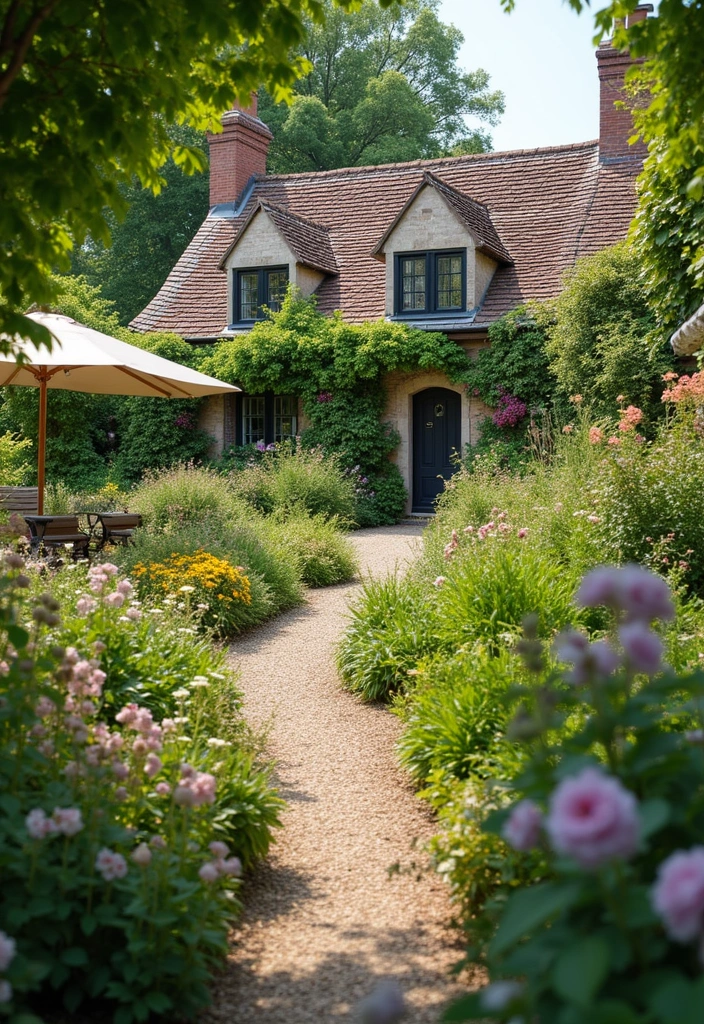
Crafting a cottage garden is a journey filled with creativity, joy, and connection to nature.
By embracing these 28 design tips, you can create a stunning retreat that brings seasonal beauty to your life while enriching the environment. Your garden can become a beloved sanctuary, where every bloom tells a story and every corner offers peace. Embrace the process and enjoy each step of creating your cozy outdoor haven!
Note: We aim to provide accurate product links, but some may occasionally expire or become unavailable. If this happens, please search directly on Amazon for the product or a suitable alternative.
This post contains Amazon affiliate links, meaning I may earn a small commission if you purchase through my links, at no extra cost to you.
Frequently Asked Questions
What Are the Best Seasonal Flowers to Include in My Cottage Garden?
To create a vibrant cottage garden, consider incorporating a variety of seasonal flowers! In spring, you might choose daisies, tulips, and peonies for their cheerful blooms. As summer approaches, add sunflowers and lavender for a pop of color and fragrance. In the fall, think about chrysanthemums and asters to keep your garden lively. By planning wisely, you can have continuous blooms throughout the seasons!
How Can I Create Cozy Seating Areas in My Cottage Garden?
Creating cozy seating areas is essential for enjoying your cottage garden! Start by selecting rustic furniture, like a wooden bench or a comfy lounge chair, to blend with the natural surroundings. Position your seating in a way that offers views of your favorite flowers or garden features. Don’t forget to add cushions for comfort and perhaps a small table for drinks or snacks. Consider surrounding your seating with fragrant plants to enhance the ambiance!
What Are Some Effective Planting Tips for a Cottage Garden?
When planting in your cottage garden, aim for a mix of colors and textures to create visual interest. Group plants with similar water and sunlight needs together to simplify care. Consider using companion planting to enhance growth and deter pests. Additionally, be sure to plan for year-round interest by selecting plants that bloom in different seasons. This way, your garden will always be a feast for the eyes!
How Can I Attract Pollinators to My Cottage Garden?
Attracting pollinators is a wonderful way to support biodiversity in your cottage garden! Start by planting a variety of nectar-rich flowers that bloom at different times of the year. Consider flowers like lavender, bee balm, and coneflower. Avoid pesticides that can harm these beneficial insects, and provide habitat options like native shrubs and a shallow water source. Your garden will thrive as pollinators visit and help your plants flourish!
What Are Some Creative Ideas for Seasonal Decor in My Cottage Garden?
Seasonal decor can add charm and personality to your cottage garden! In the spring, consider using pastel-colored decorations, like painted pots or floral wreaths. During the summer, hang fairy lights or colorful bunting for festive vibes. In autumn, you might incorporate pumpkins and gourds, while winter can be celebrated with evergreen arrangements and twinkling lights. Changing your decor with the seasons keeps your garden feeling fresh and inviting!
Related Topics

